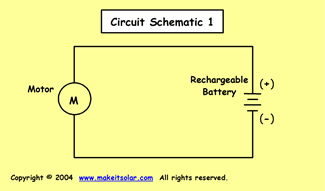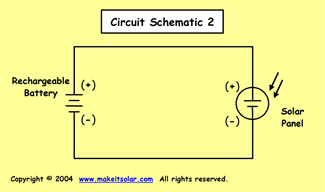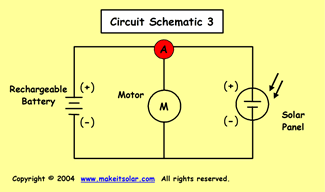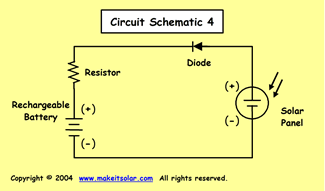Solar Battery Charger Calculations
Solar panels can supply electricity immediately to our homes. However, when the Sun sets or there is a cloudy day we won't get any power from the solar panels. Since we still want electricity when the Sun is not available we can use batteries to store power that can be used anytime.
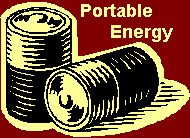
Do not build this project. This project requires special knowledge in battery technology. This is only presented for educational purposes through calculations.
Need a calculator? Calculatorsoup.com
Do not attempt to build this project.
Science Fair Idea/ Objective:
To demonstrate the theory and operation of a solar battery charger through circuit calculations.
Circuit Schematic 1: (large image)
- Battery Stored Energy - Consider Circuit Schematic 1.
- Assumptions:
- Battery stored current is 2100 mAh
I = 2100 mAh - Motor draws 10 mA of current
C = 10 mA
- Problem: If the motor runs until the battery is dead, how long will it run from a fully charged battery?
- Background:
mA = milli-Amps
mAh = milli-Amp-hours - Look at some batteries and check the actual mAh rating. Normally, rechargeable batteries list this information while one-use batteries do not.
- The calculation is simple division.
I ÷ C = T
2100 mAh ÷ 10 mA = 210 hours - Problem: What is the total motor run time if
I = 1800 mAh and
C = 10 mA - Problem: If the total run time from a fully charged battery is 205 hours and the battery rating is 1845 mAh, what is the current draw of the motor.
Circuit Schematic 2: (large image)
- Battery Charging - Consider Circuit Schematic 2
- Assumptions:
- Battery maximum stored current is 2100 mAh
- In full sun the solar panel can deliver 110 mA of current
- Problem: If the battery is dead, how long will it take to fully charge it with the solar panel?
Circuit Schematic 3: (large image)
- Solar Battery Charger with Motor - Consider Circuit Schematic 3
- Assumptions:
- In full sun the solar panel will deliver 110 mA of current
- Motor draws 10 mA of current
- Battery stored current is 2100 mAh
- Problem: How many mA of current are delivered to the rechargeable battery?
- Background: This is a parallel circuit so the current will split at the connection node A.
Total current into node A = Total current out of node A.
So, current from the panel minus current used by the motor equals current delivered to the battery. - If the battery was dead when charging started, how long will it take to fully charge the battery?
- If the battery recharging efficiency is actually 70% of the current load delivered to it, how long will it take to recharge the battery?
- Background: Currently available rechargeable batteries do not charge at 100% efficiency. They will only store about 70% of the current they receive. Therefore, the realistic charging time of a battery is greater than the time calculated in 9.
- When the Sun is not available the motor will run from the stored energy in the battery. If there is a loss of 0.5 mA from the battery back into the solar panel, how long will the motor run from a fully charged battery? Compare this answer to the answer for #2.
- Background: There is usually a loss of current from batteries back into solar panels. In this circuit with these components that loss is about 0.5 mA. The loss in this circuit is trivial but in commercial systems it is important to stop this loss. A blocking diode is used to stop the leakage. The total draw on the battery will be the draw of the motor plus the draw of the solar panel
Further Research:
Circuit Schematic 4: (large image)
- Resistors and Diodes - Consider Circuit Schematic 4
- Commercial solar battery chargers are more complex than any of the ones show here, even number 4. They use additional components including resistors and diodes. Do research to answer the following questions:
- What is the purpose of the resistor in Circuit Schematic 4?
- What is the purpose of the diode in Circuit Schematic 4?
See our other pages for ideas for a science fair project in solar energy.
